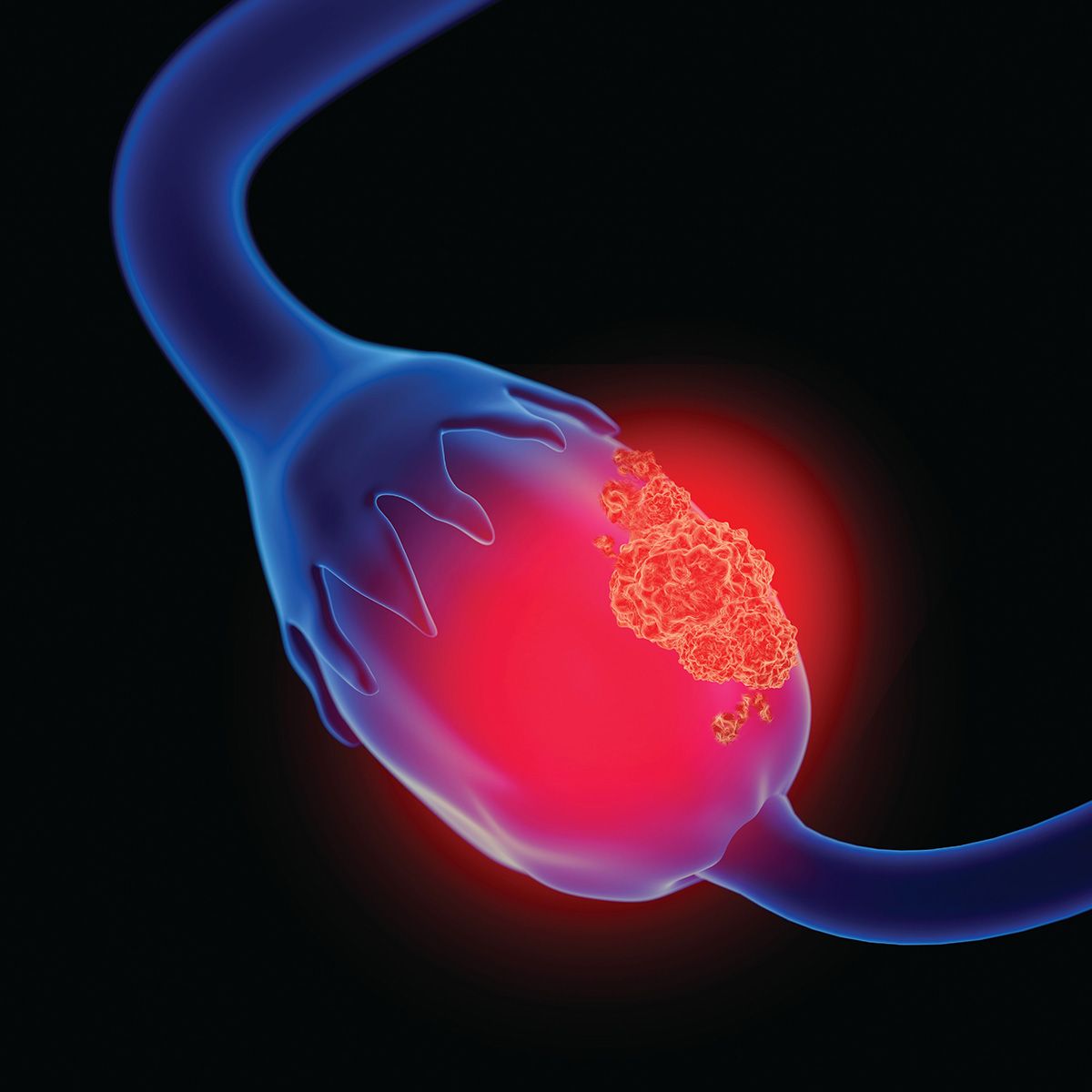Article
Phase 3 Study Data Represent 'Breakthrough' for Patients With Ovarian Cancer
Author(s):
A cohort of patients with ovarian cancer saw survival benefit with niraparib in a recent phase 3 study.
Risk of progression or death was reduced by 73 percent compared with placebo when patients with germline BRCA-positive platinum-sensitive, recurrent ovarian cancer used the PARP1/2 inhibitor niraparib, according to findings from the the phase 3 NOVA trial presented at the 2016 European Society for Medical Oncology (ESMO) Congress and published in the New England Journal of Medicine (NEJM).
After a median follow-up of 16.9 months, the median progression-free survival (PFS) with maintenance niraparib was 21 months compared with 5.5 months for placebo in patients with germline BRCA mutations. These findings remained consistent across subgroups of patients, including those without BRCA mutations.
“This is a breakthrough for patients with ovarian cancer,” lead investigator Mansoor Raza Mirza, M.D., chief oncologist at Rigshospitalet, Copenhagen, Denmark, said in a statement. “We have never seen such large benefits in progression-free survival in recurrent ovarian cancer. Once it is approved by the regulatory authorities, I’ll consider niraparib for all my patients with recurrent ovarian cancer who respond to platinum, regardless of BRCA status."
The phase 3 study randomized patients in a 2 to 1 ratio across two independent cohorts. In the first cohort, 201 patients with germline BRCA mutations received niraparib at 300 mg daily (138 patients) or placebo (65 patients). In the second cohort, 345 patients with non-germlineBRCA-mutant tumors received the PARP Inhibitor (231 patients) or placebo (114 patients). Patients in this group were tested for homologous recombination deficiency (HRD), and could be either positive (162 patients) or negative (134 patients). Of those who tested positive, 47 had somatic BRCA mutations and 115 were wild-type.
Patient demographics were well balanced between the arms for each cohort. In the germline BRCA group, the median age was 57 years and 65.9 percent had an ECOG performance status (PS) of 0. In the placebo group, the median age was 58 years and 73.8 percent of patients had an ECOG PS of 0. Overall, 48.6 percent and 53.8 percent of patients had received three or more prior therapies, in the niraparib and placebo arms, respectively.
Across both cohorts, the majority of patients had stage 3 cancer (68.8 percent to 74.1 percent). Approximately half of patients had achieved a complete response to prior platinum-based therapy and a quarter had received prior bevacizumab. In the non-BRCA-mutant arm, 33.8 percent and 32.8 percent of patients had received three or more prior therapies.
In the germline BRCA mutation group, the chemotherapy-free interval was 22.8 months with niraparib compared with 9.4 months for placebo. The median time to subsequent therapy was 21 months with niraparib versus 8.4 months with placebo.
"The effectiveness of platinum-based chemotherapy diminishes over time, and PFS and platinum-free intervals generally become shorter after each round of platinum treatment. In addition, the incidence of infection and risk of neuropathy and hypersensitivity with certain chemotherapy agents rises with subsequent cycles," Mirza noted. "An oral maintenance treatment that could lengthen the PFS interval between rounds of platinum-based chemotherapy would be very meaningful for patients with ovarian cancer, who often live with a fear of recurrence after ending active treatment."
The median time to progression or death during the first subsequent therapy following the study (PFS2) was 25.8 months for those who received maintenance niraparib versus 19.5 months for placebo.
Findings for overall survival were not yet mature (fewer than 20 percent of events). At the time of the analysis, niraparib had reduced the risk of death by 27 percent versus placebo, although this finding was not statistically significant.
"Niraparib significantly improved all endpoints across a broad patient population, representing 70 percent of all ovarian cancer patients," said Mirza. "These landmark results could change the way we treat this disease.”
In patients with HRD-positive, BRCA wild-type tumors, median PFS was 9.3 versus 3.7 months for niraparib and placebo, respectively. In those with HRD-positive, somatic BRCA-mutated tumors, the median PFS was 20.9 months with niraparib versus 11.0 months for placebo. In patients with HRD-negative, non-germline BRCA-mutated tumors, median PFS was 6.9 versus 3.8 months for niraparib and placebo, respectively.
In those with non-germline BRCA mutations regardless of HRD status, the median chemotherapy-free interval was 12.7 versus 8.6 months for niraparib and placebo, respectively. The median time to subsequent therapy was 11.8 versus 7.2 months and the median PFS2 was 18.6 and 15.6 months for the niraparib and placebo arms, respectively.
“Personalized medicine has arrived in high-grade serous ovarian cancer,” commented Andrés Poveda, M.D., head of the Gynecological Cancer Clinic, Oncology Foundation Institute Valencia, Spain, in a statement released by ESMO. “This was the first trial to use HRD to select patients for treatment and showed that it is a useful strategy. We also know that PARP inhibitors benefit patients with BRCA mutations.”
Across cohorts, 14.7 percent of 367 niraparib-treated patients discontinued therapy due to an adverse event (AE) compared with 2.2 percent of the 179 patients in the placebo arm. There were no treatment-related deaths in the study. In the follow-up period, one patient in the niraparib arm and two in the placebo group died of myelodysplastic syndrome or acute myeloid leukemia. One of these deaths in each arm was deemed to be treatment related.
The most common all-grade AEs for niraparib versus placebo, respectively, were nausea (73.6 percent vs 35.2 percent, respectively), thrombocytopenia (61.3 percent vs 5.6 percent), fatigue (59.4 percent vs 41.3 percent), anemia (50.1 percent vs 6.7 percent), constipation (39.8 percent vs 20.1 percent), vomiting (34.3 percent vs 16.2 percent) and neutropenia (30.2 percent vs 6.1 percent).
The most common grade 3/4 AEs in the niraparib arm were hematologic, and included thrombocytopenia (33.8 percent), anemia (25.3 percent) and neutropenia (19.6 percent). The most common non-hematologic AEs were hypertension (8.2 percent), fatigue (8.2 percent) and nausea (3 percent). A majority of hematologic AEs were experienced in the first three cycles.
“The current options for maintenance therapy in the European Union (EU) are bevacizumab, which can only be given once and improves progression-free survival by just a few months, and the PARP inhibitor olaparib, which is only approved in patients with a germline BRCA mutation (about 10 percent to 15 percent of ovarian cancer patients)," said Mirza. "No maintenance therapy is approved outside the EU.”
Tesaro, the company developing niraparib, initiated a rolling submission of data from the NOVA trial for a new drug application in September 2016, after receiving a fast track designation from the FDA. The company expects a full submission of the data to be complete by the end of the year. A similar marketing authorization application is anticipated in the EU.















